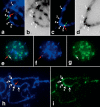DNA methylation and heterochromatinization in the male-specific region of the primitive Y chromosome of papaya
- PMID: 18593814
- PMCID: PMC2593574
- DOI: 10.1101/gr.078808.108
DNA methylation and heterochromatinization in the male-specific region of the primitive Y chromosome of papaya
Abstract
Sex chromosomes evolved from autosomes. Recombination suppression in the sex-determining region and accumulation of deleterious mutations lead to degeneration of the Y chromosomes in many species with heteromorphic X/Y chromosomes. However, how the recombination suppressed domain expands from the sex-determining locus to the entire Y chromosome remains elusive. The Y chromosome of papaya (Carica papaya) diverged from the X chromosome approximately 2-3 million years ago and represents one of the most recently emerged Y chromosomes. Here, we report that the male-specific region of the Y chromosome (MSY) spans approximately 13% of the papaya Y chromosome. Interestingly, the centromere of the Y chromosome is embedded in the MSY. The centromeric domain within the MSY has accumulated significantly more DNA than the corresponding X chromosomal domain, which leads to abnormal chromosome pairing. We observed four knob-like heterochromatin structures specific to the MSY. Fluorescence in situ hybridization and immunofluorescence assay revealed that the DNA sequences associated with the heterochromatic knobs are highly divergent and heavily methylated compared with the sequences in the corresponding X chromosomal domains. These results suggest that DNA methylation and heterochromatinization play an important role in the early stage of sex chromosome evolution.
Figures




References
-
- Arumuganathan K., Earle E.D. Nuclear DNA content of some important plant species. Plant Mol. Biol. Rep. 1991;9:208–218.
-
- Bachtrog D. Accumulation of Spock and Worf, two novel non-LTR retrotransposons, on the neo-Y chromosome of Drosophila miranda. Mol. Biol. Evol. 2003;20:173–181. - PubMed
-
- Bachtrog D. Expression profile of a degenerating neo-Y chromosome in Drosophila. Curr. Biol. 2006;16:1694–1699. - PubMed
-
- Bachtrog D., Charlesworth B. Reduced adaptation of a non-recombining neo-Y chromosome. Nature. 2002;416:323–326. - PubMed
-
- Bull J.J. Evolution of sex determining mechanisms. Benjamin Cummings; San Francisco, CA: 1983.
Publication types
MeSH terms
Substances
LinkOut - more resources
Full Text Sources
